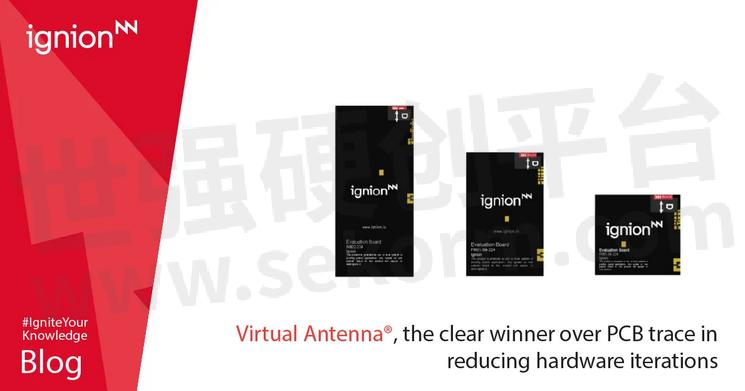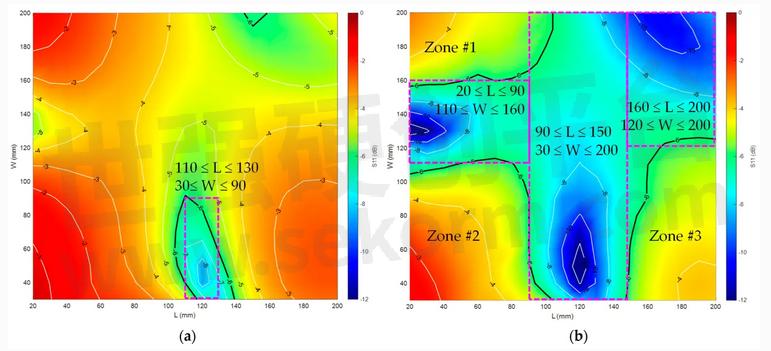Virtual Antenna®, the clear winner over PCB trace in reducing hardware iterations





Traditionally, antenna designers have grappled with the demanding task of maintaining high RF performance throughout the product design process without altering the antenna’s geometry or the matching network. However, with Ignion’s Virtual Antenna® technology, we have unlocked a game-changing solution that maintains superior performance without the need for intricate changes during the design process.
This is relevant for most IoT device development where the initial form factor and dimensions typically change, affecting the RF performance resulting in redesigns of the antenna solutions. Device designers on tight schedules often opt for using ready-made IoT modules with antennas embedded, and then typically mounted on a bigger main PCB. While the IoT module antenna might perform well in isolation, the RF performance can get significantly affected by integration with the main PCB.
Here's why Virtual Antenna® components are the preferred choice for resilient antenna systems:
Preserving Performance: Virtual Antenna® technology allows us to maintain performance consistency across various device dimensions without modifying the antenna’s structure or the matching network. This means that if requirement changes occur or if using a module is mounted on a main PCB, you can expect the same high-quality performance consistently.
Cost-Efficiency: With Virtual Antenna® technology, we maximize the utilization of the existing Bill of Materials (BoM). This minimizes the need for expensive alterations and ensures that your antenna system remains budget-friendly even if hardware changes occur while delivering exceptional results.
Virtual Antenna® technology, far more resilient than PCB trace monopole antenna – the analysis of different ground plane sizes
The performance of the Virtual Antenna® technology and PCB trace monopole antenna has been analyzed under the same challenging conditions including ground planes ranging from a small ground plane of 20 mm x 30 mm up to 200 mm x 20 mm. The figure below illustrates the worst S11 reflection coefficient in both antenna systems between 863 to 928 MHz while keeping the same BoM (antenna part and matching network) for both cases. The maps demonstrate that Virtual Antenna® technology is far less affected when modifying the ground plane dimensions of the IoT device. In particular, for the PCB trace monopole antenna, only 4.6% of the devices satisfy a S11<-6dB threshold. However, such reuse increases to 53.8% for the Virtual Antenna®.

Figure: Worst S11 in the 863–928 MHz frequency range for the PCB trace monopole antenna (a) and Virtual Antenna® component (b) as a function of the length L and width W of the ground plane. Both designs are embedded on a small 20 mm x 11 mm clearance area.
In practical terms, when embarking on the journey of developing an IoT device, designing with Virtual Antenna® technology offers greater resilience and flexibility compared to PCB trace antennas. Very few projects end up being exactly as planned, meaning that using a resilient antenna technology will save you costly design iterations. Typically, just one extra hardware spin can cause several months of delay due to production and bring-up time.
To try using Virtual Antenna® technology today, visit the free-to-use Antenna Intelligence Cloud™ tool.
- |
- +1 赞 0
- 收藏
- 评论 0
本文由玄子转载自Ignion Blog,原文标题为:Virtual Antenna®, the clear winner over PCB trace in reducing hardware iterations,本站所有转载文章系出于传递更多信息之目的,且明确注明来源,不希望被转载的媒体或个人可与我们联系,我们将立即进行删除处理。
相关研发服务和供应服务
相关推荐
The True Cost of an Antenna in IoT Design: Cost Implications when Making the Critical Choice
The key takeaway for IoT designers is to adopt a holistic view of project costs influenced by the antenna. Focusing solely on individual antenna component pricing can be misleading as long-term savings and efficiency gains of an optimal antenna solution are likely even more important to consider for any serious IoT project.
Getting the Best Cellular IoT Antenna Performance: Why It’s Better to Focus on the Specific Bands in Your Region
In the process of creating IoT devices, one crucial decision revolves around choosing the right cellular RF module and its associated antenna. The RF module handles wireless communication and operates within specific frequency bands. However, not all global cellular bands are likely to be relevant for your IoT device. From an antenna perspective it’s better to focus on covering the bands specific to your deployment region.
NN03-320双核MxTend™天线功率放大器规格书
描述- DUO mXTEND™ (NN03-320) 是一款多用途的物联网芯片天线组件,具有两个独立端口。该组件专为全球范围内的 GNSS 和蓝牙连接设计,同时支持 5G 和 UWB 等频段。其特点是尺寸小巧(7.0mm x 3.0mm x 2.0mm),无需额外空间,适用于多种设备。
型号- NN03-320
AI & Machine Learning: Simplifying IoT Antenna Integration with Virtual Antenna® Technology
Ignion has embraced this opportunity Artificial Intelligence (AI) and Machine Learning (ML) to automate the development process for its Virtual Antenna® technology, giving the IoT market access to a powerful, useful and ML-powered digital twin design tool—Antenna Intelligence Cloud™.
Kinghelm Omnidirectional Antenna KH-GNSS.WLAN-FAKRA-L3M : The Superior Connector for Mobile Communications and IoT
In today’s fast-paced world, reliable connectivity is the backbone of modern communication, especially in industries requiring high-performance wireless solutions. The KH-GNSS.WLAN-FAKRA-L3M by Kinghelm is an advanced omnidirectional antenna designed to meet the demanding connectivity needs of 4G communication and WLAN systems. Offering optimal signal coverage and enhanced stability, this compact yet powerful antenna ensures uninterrupted data transmission across a variety of applications, including vehicle navigation, IoT devices, and mobile surveillance systems.
Ignion提供Virtual Antenna™技术用于可穿戴设备,以提高物联网生态系统设计效率
Virtual Antenna™技术用新型天线增强器取代传统和定制天线解决方案,以新系列的微型和现成芯片天线组件的形式交付。Comp Tech Sales将其添至旗下可穿戴设备中,和ignion为整个物联网生态系统的最小设备提供更快的设计、更高的性能和效率。
TE Connectivity to acquire antennas business from Laird Connectivity
TE Connectivity (TE) are pleased to announce that TE signed a definitive agreement to acquire the antennas business from Laird Connectivity.
可穿戴设备的Nano MxTend™:接地层性能评估
描述- 本应用笔记详细评估了NANO mXTEND™虚拟天线在可穿戴设备中的应用性能。该天线专为小型PCB设计,适用于2.4 GHz频段,包括蓝牙、Wi-Fi和Zigbee等通信协议。笔记中分析了不同PCB尺寸和形状对天线性能的影响,并提供了匹配网络设计、VSWR和效率等关键参数。此外,还考虑了人体对天线性能的影响,并提供了相应的解决方案。
型号- NN02-101
TE Connectivity(泰科)轨道天线选型指南
目录- Onboard Antennas Vehicle Antennas (Semi) Stationary Antennas
型号- 1-2823602-1,1-2823602-2,2321811-1,1-2316881-1,1-2309605-1,1-2309646-1,1-2823595-1,2344721-1,1-2823595-2,1-2823596-1,1-2823593-1,2344721-2,2332157-1,1-2823594-1,2344721-3,2344721-4,1-2823598-2,1-2823599-1,2344721-5,1-2823599-2,2344721-6,1-2823596-2,1-2823597-1,1-2823597-2,1-2823598-1,2332157-3,2332157-2,2332157-4,1-2823591-1,1-2823592-1
Kinghelm Bluetooth Chip Antenna KH-3216-H0209: High Performance and Reliability for Wireless Communication
The Kinghelm bluetooth chip antenna KH-3216-H0209 is a high-performance wireless communication chip antenna optimized for the 2.4GHz frequency band. With its excellent performance parameters and steady operation, this bluetooth chip antenna has become a popular choice in wireless communication, IoT and smart devices.
小型蓝牙设备的天线设计白皮书
描述- 本文探讨了小型蓝牙设备天线设计的关键要素,旨在帮助制造商通过使用SiP模块和优化天线设计来减小设备尺寸。文章分析了PCB天线和芯片天线的优缺点,介绍了SiP模块在小型物联网设备中的应用,并提出了三个天线设计规则,包括SiP模块的放置、天线间隙和定制天线设计,以确保在不牺牲无线性能的情况下最大化设备尺寸。
Ignion’s New AI-powered Antenna Integration Platform Oxion™ is Shorten the Design Time of Wireless Devices
Ignion announced today the launch of Oxion™, a development platform to shorten the design time of wireless devices. Powered by AWS, IoT device developers can leverage the power of AI/ML in real-time to avoid wireless connectivity roadblocks and make their projects materially easier to get to market.
Ignion Announces the Smallest Virtual Antenna™ at the Wi-Fi World Congress Which is with a size of only 3x2x0.8mm
Ignion has announced the smallest Virtual Antenna™ ever at the Wi-Fi World Congress. With a size of only 3 x 2 x 0.8 mm, the NANO mXTEND™ is ideal for miniature Wi-Fi devices that require a reliable and repetitive antenna solution.
Ignion´s Compact Antenna Powers 4K Streaming in Wireless Surgery
Engineering firm Izertis chose Ignion´s application engineers as they were confident that Ignion´s expertise would be crucial in achieving maximum antenna efficiency in their Wireless Arthroscopy Device. Ignion team was up to the challenge of providing the guidance needed to find the optimal antenna component. Two parallel working ONE mXTEND™ antenna boosters were chosen.
Virtual Antenna® Enables Reliable Cellular Connectivity for Withings’ New Product Line
Withings and Ignion collaborated on the design using Ignion’s RUN mXTEND™ antenna booster to provide cellular connectivity in a small form factor. The final product was brought to market in less than one year and met all the high standards of the Withings Pro range of products.
电子商城
现货市场
服务
Ignion可支持多协议、宽频段的物联网天线方案设计,协议:Wi-Fi、Bluetooth、UWB、Lora、Zigbee、2G、3G、4G、5G、CBRS、GNSS、GSM、LTE-M、NB-IoT等,频段范围:400MHz~10600MHz。
最小起订量: 2500 提交需求>











































































































































































































登录 | 立即注册
提交评论